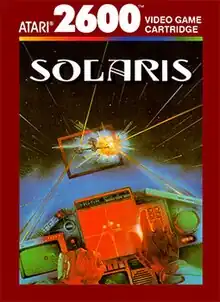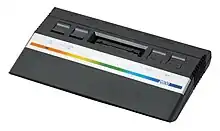Solaris (video game)
Solaris is a space combat game for the Atari 2600 published in 1986 by Atari Corporation. It was programmed by Doug Neubauer.[2]
| Solaris | |
|---|---|
 | |
| Publisher(s) | Atari Corporation |
| Programmer(s) | Doug Neubauer |
| Platform(s) | Atari 2600 |
| Release | November 1986 |
| Genre(s) | Space combat simulator[1] |
| Mode(s) | Single-player |
Gameplay
The galaxy of Solaris is made up of 16 quadrants, each containing 48 sectors.[3] The player uses a tactical map to choose a sector to warp to, during which they must attempt to keep their ship "in focus" to lower their fuel consumption rate. Fuel must be carefully managed, as an empty tank results in loss of one of the player lives. Space battle ensues whenever the player navigates into a hostile battlegroup via the tactical map. Space enemies include pirate ships, mechanoid ships, and aggressive "cobra" ships. Each battlegroup has at least one enemy flagship, which shoots out fuel-sapping drones.[4]
The player may also descend to one of 3 types of planets:
- Friendly federation planets, which provide for refueling, but may also harbor a planet defense mission if they are under attack. If players allow a friendly planet in a quadrant to be destroyed, that quadrant becomes a "red zone" where joystick controls are reversed and booming sounds are overheard.
- Enemy Zylon planets, in which the player must rescue all cadets, gaining an extra ship when all cadets are rescued.
- Enemy corridor planets, in which the player must traverse through a fast-paced corridor.
There are 4 kinds of ground enemies found on planets: stationary guardians, gliders, targeters and raiders. The ultimate goal of Solaris is to reach the planet Solaris and rescue its colonists, at which point the game ends in victory.
Production

Prior to working on Solaris, Neubauer worked as independent contractor making film tie-in games for 20th Century Fox's new game division making Alien and Mega Force and M*A*S*H. Neubauer had hoped that making several video game adaptations would lead to making a film license like Star Wars, finding that "just because a company makes a movie doesn't mean they have the rights to make a video of the movie, Case in point, Star Wars. They didn't have the rights to it."[5]
Douglas Neubauer pitched the game to Atari in 1984 who were going to turn it into a tie-in game for the film The Last Starfighter (1984). Atari flew Neubauer to Los Angeles for a screening of the film and then shortly found after that Jack Tramiel had bought the company and had most of the staff laid off. In 1986, Atari contacted Neubauer to revive the game. He was working at Imagen at the time doing chip and systems design.[6] The Atari 2600 was experiencing what video game historian Brett Weiss described as "a resurgence of sorts" after Nintendo had success in the marketplace with the Nintendo Entertainment System.[7] Atari had just re-released the system a smaller budget-priced revision in 1986.[8]
The game was made with 16K of bank-switching RAM and 256 bytes of RAM.[5][9] Neubauer had his cousin Randy Emberlin help him with the graphics for the game, who was a professional comic artist.[5] Neubauer stated that he "handed everything over to Atari [including] the 'master EPROM' of the game and my engineering notes. [...] Little did I suspect that they would take my engineering notes, almost verbatim, and make a manual out of it, including the primitive little sketches I did. Apparently Atari was cash-strapped at the time, but so strapped they couldn't afford a graphics artist?"[6] Solaris was completed by October 1986.[10]
Release
Solaris was released for the Atari 2600 in November 1986.[11]
The game was included as part of the Atari 50: The Anniversary Celebration (2022) compilation for Nintendo Switch, PlayStation 4, Steam, and Xbox One.[12]
Reception and legacy
From contemporary reviews, The Video Game Update gave the game their highest rating of four stars for both graphics and gameplay.[9] The review proclaimed the game was "strong enough to hold its own in an era of game systems far greater capabilities than the modest 2600" and that "Without question Solaris is the best space game ever done for this system."[9]
From retrospective reviews, Retro Gamer stated in issue 176 of that "the real feature of Solaris that will make your jaw drop is the visuals. You would have never thought it was possible for the 2600 to display high-res graphics in so many colours." and that the game was "widely regarded as the console's most technically impressive commercial release."[13] In their list of the top 25 Atari 2600 games, Stuart Hunt and Darran Jones listed Solaris in at their 16th spot in Retro Gamer.The writers declared that the game "can be heralded as one of the infest pieces of code written for the 2600."[14] noting that it had graphics that rarely flicker or dissolve that were "some staggering visuals" while noting that the gameplay will take some used to.[14] Jonathan Sutyak writing for the online game database Allgame found the graphics were "the Atari 2600" at its best" while finding that the shooting scenes in the game were not enjoyable. Sutyak continued that it should have been simplified to make it fun and that "trying to make sense of everything is not worth your time or effort."[1]
Following its release Neubauer went on to make other Atari 2600 games including Super Football and Radar Lock. He had attempted to make a space-oriented game for NES that was never published, stating that "the days of one programmer doing a complete game were over, and by the time I got the game done, the NES was obsolete."[5] Neubauer reflected on his games stating "the best games I did were the ones I did for fun rather than money. Probably a lesson there."[5][13] When comparing the game to Star Raiders, Neubauer thought that Star Raiders had better game play and he preferred that games' explosion graphics but that he preferred the pure cockpit view of Star Raiders.[15]
See also
References
- Sutyak.
- Barton & Loguidice 2009.
- "Solaris manual". archive.org. Atari Corporation. 1986.
- "Pushing the limits: Solaris". Retro Gamer. p. 176. Retrieved 25 February 2021.
- "Video Games' First Space Opera: Exploring Atari's Star Raiders". Gamasutra. Archived from the original on February 27, 2008. Retrieved June 16, 2023.
- Oxford 2012.
- Weiss 2014, p. 119.
- Digital Eclipse (November 11, 2022). Atari 50 (Nintendo Switch). Atari.
Highs and Lows: The 2600 "Jr.": In addition to the 7800, Atari also rolled out a smaller, budget-priced revision of the 2600. Retailing for just $49.99, it was a very affordable alternative, and Atari began to put more 2600 games on the shelves.
- "Critically Speaking...Atari 2600 Compatible". The Video Game Updates. January 1987. p. 12.
- Pappas 1986, p. 90.
- "Availability Update". The Video Game Update. Vol. 5, no. 9. December 1986. p. 14.
- Machkovech 2022.
- "Pushing the Limits - Solaris". Retro Gamer. No. 176. p. 52.
- Jones & Hunt.
- Bevan, p. 65.
Sources
- Barton, Matt; Loguidice, Bill (September 8, 2009). "The History of Star Raiders: Taking Command". Gamasutra. Archived from the original on September 12, 2009.
- Bevan, Mike. "Star Raiders". Retro Gamer. No. 79.
- Jones, Darran; Hunt, Stuart. "Top 25 Atari 2600 Games". Retro Gamer. No. 46. p. 27.
- Oxford, Nadia (September 24, 2012). "Solaris: The Last (Atari 2600) Starfighter". 1up.com. Archived from the original on October 8, 2012. Retrieved June 16, 2023.
- Machkovech, Sam (September 12, 2022). "The 103 Classic Games That Did, and Didn't, Make the Atari 50 Anniversary Cut — Retailer Leak Suggests Games from Arcade to Jaguar; Surprises Apparently Still Await". Ars Technica. Condé Nast. Archived from the original on September 14, 2022. Retrieved May 23, 2023.
- Pappas, Lee H. (October 1986). "An Interview with Doug Neubauer". ANALOG Computing. No. 47.
- Sutyak, Jonathan. "Solaris". AllGame. Archived from the original on November 14, 2014. Retrieved June 16, 2023.
- Weiss, Brett (2014). The 100 Greatest Console Video Games 1977-1987. Schiffer Publishing. ISBN 978-0-7643-4618-7.
External links
- Solaris at Atari Mania
- Solaris at AtariAge
- Interview with Doug Neubauer
- Doug Neubauer on the Solaris manual